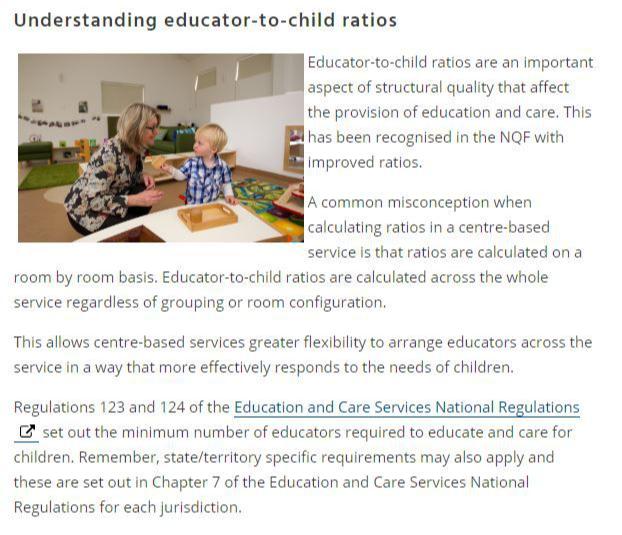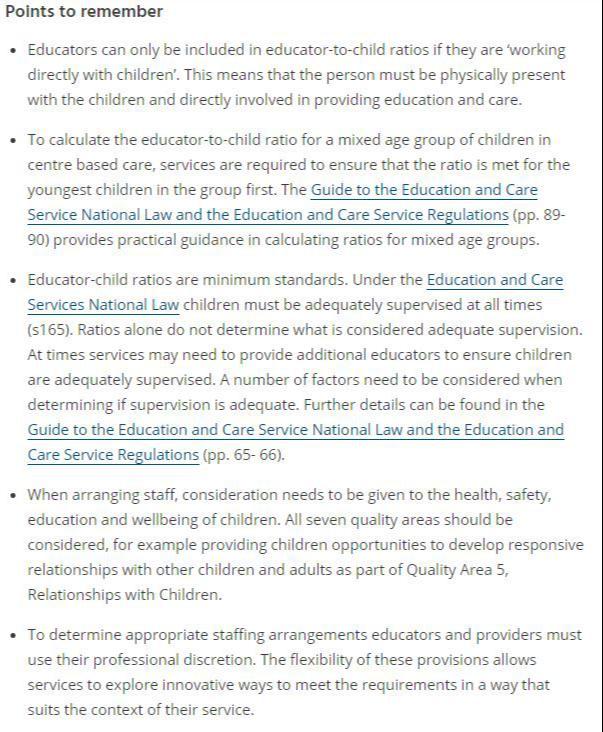If you cringe when the words 'Under the roof' are uttered, then chances are you’re doing it wrong.
The Australian National Quality Framework (NQF) brought with it ratios intended to improve outcomes for children. The notion of determining ratio of educator:child under the roofline (or across the service) was not a free ticket to run a service with ratios that are stressful for both children and educators alike. That’s just dumb.
Firstly, you won’t find the term 'under the roof' in the Regulations. It is a thing… but it’s not a thing. Under the National Regulations (henceforth referred to as the Regs), the minimum educator to child ratios are calculated across the service. So, the number of educators required is calculated based on all children under a single roof, regardless of the room configuration (see the educator-to-child ratios page for more information). This information about ratios calculated 'under a single roof' was not printed in the Regs. It was, however, shared by the Office of Early Childhood Education and Care in QLD on the DETA website. It may have been distributed elsewhere, but it is possible that this is where the term 'under the roofline' that has caused so much conjecture may have come from. Here's a screen shot. Click on the image to head to the DETA website where this was stated (link was active at date of posting 17.05.2016 and yes I know we don't have rations - don't blame me for the typo, it's a screen shot).
Here's a little more from the same article...
For those of us that were around in the days of counting heads and moving children through spaces to ensure constantly upheld ratios, we breathed a sigh of relief with this information and the new Regs. Well... that was until the misunderstanding and blatant abuse of this flexibility started to impact children.
Take these examples:
“I’m so exhausted because I’ve been the only educator in a babies' room with 6 babies on my own all day, because we run under-the-roof ratio”.
You’re doing it wrong.
“Our centre uses under-the-roof ratio which leaves us grossly out of ratio and I worry about safety and supervision of the children”.
You’re doing it wrong.
“Sometimes we have one extra child in Toddler 1 room and one less in Toddler 2 room on a given day. We used to move one child into a different room all day to fix the ratio, which left that child crying and distressed at the door, wanting to go back to their own room. These days, Toddler 1 and Toddler 2 room educators plan for both groups of children and we open the gate between the rooms for some of the day. We now ensure that both educators are working towards the outcomes of both the groups of children. We worry less about getting the ratio perfect and more about being responsive to the individual needs of the children”.
Well that makes a whole lot more sense, doesn’t it? So how do we know what’s right and what’s not?
Stop taking other people’s word for it, and make sure you check for yourself.
I’ll summarise some stuff here, but please don’t take my word for it. Look for yourself. That’s what you should be doing, whenever something doesn’t feel right. Sure, ask a colleague, then ask them to tell you where to find it yourself. Don’t assume it’s right before doing that. If it doesn’t seem right and you don’t see it in black and white in the Law, Regs, or a guide distributed by ACECQA, then chances are… it’s crap. Let’s take a closer look…
According to staffing arrangements outlined in Part 4.4 of the National Regulations, the educator-to-child ratios and qualification requirements outlined in regulations 123, 125 to 135 are dependent on the size and nature of the service. No matter the grouping of the children, the ratio required is always calculated according to the age of the youngest child allocated to an educator for the purposes of calculating ratios. In accordance with regulation 121, the minimum number of educators and their qualification requirements are calculated across the service, regardless of the individual room configuration. This was the exciting thing about the new Regs! It meant ratios are no longer calculated on the number of children and educators present in a group or ‘room’. Be gone with the counting heads and moving bodies in and out of spaces to meet ratio. This flexibility in calculating ratios allows services the ability to tailor the operation of their service to meet the needs of families and children. Well, that was the intention. What followed has been a blatant misuse of this flexibility at some services, which has led to confusion and even anger about this ratio regulation blessing. On the bright side, most high quality services have been supported by regulations that make sense to their way of operating. When determining groupings of children, in their best interests, they have therefore been able to provide unique, responsive groupings from mixed age, indoor/outdoor flow, family grouping, even free-flow environments where children can move between any of the rooms of a centre throughout the day. At the very least, these Regs have ensured that children have not been disrupted, for example, when the service is short staffed for a day and the ratio in one room is out by one child. In the past, I witnessed on many occasions the oldest child from the group being moved to an unfamiliar room with unfamiliar educator, to the detriment of that child’s wellbeing. There is some flexibility in the new Regs, all things considered, to find other solutions.
Here’s the most important bit that has seemed to have been lost in translation. You can’t have a dodgy ratio in one room on a permanent basis and say “We do under the roof ratio, so we’re all good”. Nah, actually, you’re not. Under regulation 122, the educator must be ‘working directly with children’ at the service. That’s right, ‘An educator cannot be included in calculating the educator to child ratio of a centre-based service unless the educator is working directly with children at the service.’ (An educator is still considered to be working directly with children for the purposes of the educator-to-child ratio requirements if they are taking a rest pause or are briefly absent in accordance with Regulations 313-317). Regulation 13 of the National Regulations defines ‘working directly with children’ as being both physically present with the children and being directly, actively engaged in providing education and care to the children. Directly. Actively. Engaged. Did we get that?
Let's think about this.
Am I directly engaged with the children when I'm working in another room?
Am I physically present with the children when I'm working in the office doing Supervisor or administration duties?
Am I directly engaged and actively working with the children if I am in a 1:5 ratio room, and I take 4 children out to the Veggie patch for an hour while the other educator in the room works inside with 6 children?
Then there's adequate supervision. Let's look closer at that for a moment. Because, guess what? Sometimes while you might be meeting the regs and it all seems above board, educators are stressed and adequate supervision is compromised. This is precisely why the regulations state a minimum ratio, as opposed to a set ratio, because sometimes it takes more than a minimum ratio to adequately supervise. Here's an excerpt from the NQF resource kit:
The educator-to-child ratios outlined in the National Regulations provides the minimum requirements which education and care services must meet. The Approved Provider needs to consider the size and composition of groups for educators to achieve quality education, health, safety and wellbeing outcomes for children. Beyond complying with the minimum ratios, under section 165 of the National Law the Approved Provider and Nominated Supervisor must ensure that children being educated and cared for by the service are adequately supervised at all times. Your professional judgement takes precedence here. Sometimes, this means the minimum ratio is not enough.
To sum up, a quality education and care service for children will:
* consider the ratio recommendations as a minimum, not a bench mark;
* ensure educators counted on ratio are working directly with the children they are assigned to; and
* determine ratios that allow for children to be adequately supervised at all times.
Reflect on the information, expectations, standard and regulations set out in the National Quality Framework and adjust your practice to suit . If 'under the roof' ratio calculating is happening at your service and it feels dodgy or stressful… stop it.
Additional information:
This ACECQA newsletter says it all:


Download this Article
Please subscribe below to download a printable copy of this article:
